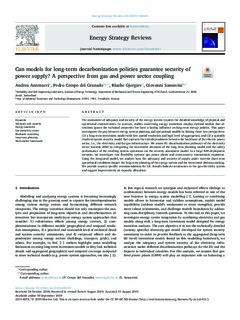| dc.contributor.author | Antenucci, Andrea | |
| dc.contributor.author | Crespo del Granado, Pedro | |
| dc.contributor.author | Gjorgiev, Blazhe | |
| dc.contributor.author | Sansavini, Giovanni | |
| dc.date.accessioned | 2020-02-03T10:22:07Z | |
| dc.date.available | 2020-02-03T10:22:07Z | |
| dc.date.created | 2019-09-25T13:22:21Z | |
| dc.date.issued | 2019 | |
| dc.identifier.citation | Energy Strategy Reviews. 2019, 26 1-11. | nb_NO |
| dc.identifier.issn | 2211-467X | |
| dc.identifier.uri | http://hdl.handle.net/11250/2639230 | |
| dc.description.abstract | The assessment of adequacy and security of the energy system requires the detailed knowledge of physical and operational characteristics. In contrast, studies concerning energy transitions employ stylized models that oftentimes ignore the technical properties but have a lasting influence on long-term energy policies. This paper investigates the gap between energy system planning and operational models by linking these two perspectives: (1) a long-term investment model with low spatial resolution and high level of aggregation, and (2) a spatially resolved system security model that captures the interdependences between the backbone of the electric power sector, i.e., the electricity and the gas infrastructure. We assess EU decarbonization pathways of the electricity sector towards 2050 by integrating the investment decisions of the long-term planning model and the safety performance of the resulting system operations via the security assessment model. In a large RES deployment scenario, we investigate two flexibility options: gas power plants and cross-country transmission expansion. Using the integrated model, we analyze how the adequacy and security of supply under extreme short-term operational conditions impact the long-term planning of the energy system and the investment decision-making. We provide country specific recommendations for UK. Results indicate weaknesses in the gas-electricity system and suggest improvements on capacity allocation. | nb_NO |
| dc.language.iso | eng | nb_NO |
| dc.publisher | Elsevier | nb_NO |
| dc.relation.uri | https://www.sciencedirect.com/science/article/pii/S2211467X19301038 | |
| dc.rights | Attribution-NonCommercial-NoDerivatives 4.0 Internasjonal | * |
| dc.rights.uri | http://creativecommons.org/licenses/by-nc-nd/4.0/deed.no | * |
| dc.title | Can models for long-term decarbonization policies guarantee security of power supply? A perspective from gas and power sector coupling | nb_NO |
| dc.type | Journal article | nb_NO |
| dc.type | Peer reviewed | nb_NO |
| dc.description.version | publishedVersion | nb_NO |
| dc.source.pagenumber | 1-11 | nb_NO |
| dc.source.volume | 26 | nb_NO |
| dc.source.journal | Energy Strategy Reviews | nb_NO |
| dc.identifier.doi | 10.1016/j.esr.2019.100410 | |
| dc.identifier.cristin | 1728893 | |
| dc.description.localcode | This article is available under the Creative Commons CC-BY-NC-ND license and permits non-commercial use of the work as published, without adaptation or alteration provided the work is fully attributed. | nb_NO |
| cristin.unitcode | 194,60,25,0 | |
| cristin.unitname | Institutt for industriell økonomi og teknologiledelse | |
| cristin.ispublished | true | |
| cristin.fulltext | original | |
| cristin.qualitycode | 1 | |

